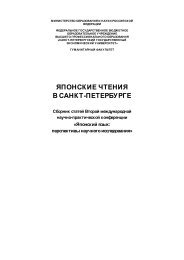to Learners with Special Educational Needs
e-textbook SEN
e-textbook SEN
Create successful ePaper yourself
Turn your PDF publications into a flip-book with our unique Google optimized e-Paper software.
Pokrivčáková, S. et al. (2015). Teaching Foreign Languages <strong>to</strong> <strong>Learners</strong> <strong>with</strong> <strong>Special</strong> <strong>Educational</strong> <strong>Needs</strong>:<br />
e-textbook for foreign language teachers. Nitra: Constantine the Philosopher University. 128 p.<br />
ISBN 978-80-558-0941-0<br />
6 Foreign language learning anxiety<br />
Zdena Kráľová & Daniela Sorádová<br />
DOI: 10.17846/SEN.2015.91-100<br />
Objectives<br />
There is a great deal of research focusing on foreign language anxiety. It is generally<br />
conceived as a significant fac<strong>to</strong>r in foreign language learning, yet there are many inconsistent<br />
conclusions. Therefore, the purpose of this chapter is <strong>to</strong> summarize the most relevant research<br />
findings on foreign language anxiety in a brief overview. The attention is paid <strong>to</strong> the definition<br />
and classification of anxiety and its causes and consequences specific for foreign language<br />
learning.<br />
Introduction<br />
Feelings and attitudes play an important role in perceiving everyday life. It is said that we get<br />
constant reports <strong>to</strong> our mind about the world through our feelings. We scan the environment<br />
and then infer the moods, feelings and create attitudes. As regards students, they often feel<br />
stressed or even anxious about a certain subject.<br />
As learning languages has its significance nowadays, there is a great deal of research focusing<br />
on foreign language anxiety (FLA). The fact that some learners are more successful at acquiring a<br />
foreign language (FL) than others even though the circumstances of a foreign language learning<br />
are almost identical has led <strong>to</strong> investigations of individual characteristics as predic<strong>to</strong>rs of<br />
successful FL learning, most of them agreeing <strong>with</strong> the following categories (Olivares-Cuhat,<br />
2010):<br />
a) cognitive fac<strong>to</strong>rs (language aptitude, learning strategies);<br />
b) affective fac<strong>to</strong>rs (attitudes, motivation, anxiety);<br />
c) metacognitive fac<strong>to</strong>rs;<br />
d) demographic fac<strong>to</strong>rs.<br />
The differences between studies over several decades in design and methodology have led<br />
researchers <strong>to</strong> draw rather conflicting conclusions about the influence of certain fac<strong>to</strong>rs on FL<br />
learning. Their results have not been consistently replicated thus they require further<br />
examination before any firm conclusions could be drawn. Due <strong>to</strong> a number of methodological<br />
and conceptual divergences and the complexity of individual differences in FL learning, the<br />
limited amount of research findings in this area could be generalized (Ehrman et al., 2003).<br />
However, researchers had <strong>to</strong> accept the fact that personality traits such as self-esteem,<br />
inhibition, anxiety, risk-taking and extraversion, may well shape the ultimate success in<br />
mastering a second language (Dörney, 2005). As there is a growing acceptance <strong>with</strong>in the FL<br />
community of learners´ feelings and reflections <strong>with</strong>in the learning process, one of the most<br />
highly examined variables in the field of FL learning is foreign language anxiety (Horwitz, 2001)<br />
and FL researchers widely conceive FLA as an obvious fac<strong>to</strong>r in FL acquisition.<br />
Defining anxiety<br />
Spielberg (1983) defines anxiety as “the subjective feeling of tension, apprehension,<br />
nervousness, and worry associated <strong>with</strong> an arousal of the nervous system.” Scovel (1991, p. 18)<br />
further states, that “anxiety is a psychological construct, commonly described by psychologists<br />
as a state of apprehension, a vague fear that is only indirectly associated <strong>with</strong> an object”.<br />
It is important <strong>to</strong> differentiate between the different types of anxiety. When anxiety is limited<br />
just <strong>to</strong> a specific situation, such as speaking in a foreign language, we use the term specific<br />
anxiety. On the other hand, the term generalized anxiety is used by those who are generally<br />
91






